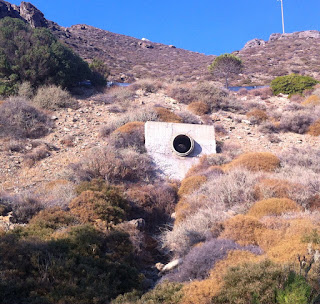For our participation in MADEINATHENS
at the Greek Pavilion in the 13th Venice Biennial, We
decided to study two iconic modernist buildings in Athens. Each of
those buildings represents a side of the current two-fold crisis
engulfing the city: The Civic side of the crisis is represented by
the housing block Chara, and the Economic side by the luxury resort
and casino of Mont Parnes.
The housing block, startlingly
different from it's surrounding cheap and profit driven
pseudo-modernist polykatoikies decides the city is no longer a friendly environment, and decides one day to leave, perhaps mirroring the
immigrants who now leave Greece for their countries and the Greeks taking off in
search of better fortunes elsewere. (Athens took it's current shape during a
mass internal migration from the 1950s and onwards, when Greeks from
every corner of the WWII and Greek Civil War ravaged country moved to
Athens for jobs and modern comforts. This was followed by a wave of
financial immigrants from Eastern Europe, North Africa and Asia that
began in the 1990s.)
The video and installation narrates the
story of the building, while going off in the theoretical future
scenario of it's transformation into an inhabitable mountain.
The casino was built in the late 1950s
with Marshall Plan funding, commisioned by the Karamanlis government.
It was to be, like many Marshall Plan constructions, a perfect
billboard for the future promised to all the NATO participating
countries, a hi-tech modernist emblem positioned on top of mount
Parnitha, visible from the entire city of Athens, and who knows maybe
even from Moscow? The building was also heavily used to promote the
Greek Economy and Tourism forces to consider in the European
landscape, and perhaps part of Karamanlis plan of Greece as a valid
European partner.
Things did not exactly turn out like
this, and the luxury resort proved to be a shaky gamble, criticized by
many as a mediocre, poorly planned building. The rooms were too small for
a mountain resort, the pool reminded one of a beach side fancy but
was too windy and cold for anybody to use, the public spaces of the hotel were hard
to navigate and offered none of the spectacular views that the
location promised. The hotel went quickly bankrupt, and began a
steady decline of alternating bankruptcies, renovations and
unsuccessful conversions into a school of tourism, a state casino, a
privately owned hotel and recently a half demolished ruin about to be
re-built as a copy of it's previous self. Between these failed
attempts to revive the building came earthquakes, fires and
structural failures just adding to the list problems for this unlucky
building. More than a capitalist gamble gone wrong, it seems as if the
mountain itself was rejecting it's modernist occupant, as if
constructing this building on top of this nature reserve was a
perfect example of hybris.
At the same time, the counties economy
underwent a similar series of failed renovations, seemingly unable to
follow the course of capitalism, as it evolved from a cold-war
political game of domination to the casino capitalism of financial
markets, and to today's crisis capitalism.
In the end, the building that was meant
as a billboard for the strength of the economy became an emblem of
it's failures, inhabiting the peak of the current economic warzone.
The project researches this history,
but takes a sharp turn into a future where the development of a
cottage economy follows the fantasy solution of a midnight explosion.
The broken pieces of the exploded casino scatter on the slopes of
Mount Parnitha and slowly grow into small shelters, the modernist
fragments helped into completion by the tree trunks of Parnitha,
hybrid cottages that escape into a future of locally grown independed
economies.
TROLLCASINO
Andreas Angelidakis 2010-2012
3D and Animation: Sotiris Vasiliou
additional work for TROLL: Dimitris Silaidos, Nana Stathi, Georgios Eftaxiopoulos, Eirini Anthouli.
addtional 3D for CASINO: Diamadis Tegelidis
photediting Alexandra Syriou
video editing AA
installation: Sotiris Vasiliou, Alexandra Syriou, AA
Andreas Angelidakis 2010-2012
3D and Animation: Sotiris Vasiliou
additional work for TROLL: Dimitris Silaidos, Nana Stathi, Georgios Eftaxiopoulos, Eirini Anthouli.
addtional 3D for CASINO: Diamadis Tegelidis
photediting Alexandra Syriou
video editing AA
installation: Sotiris Vasiliou, Alexandra Syriou, AA


















































